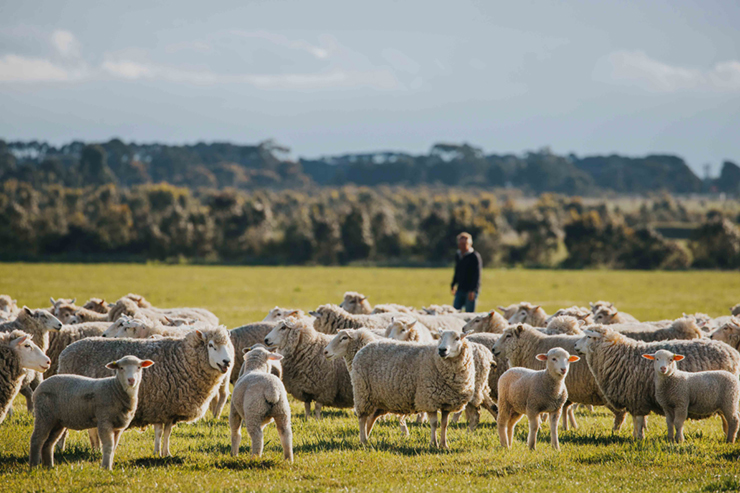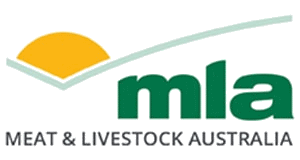Soil fertility jewel in crown at Murdeduke
08 April 2025
 Murdeduke’s stud cattle advisor Simon Falkiner, with farm manager and co-principal Lachie Wilson.
Murdeduke’s stud cattle advisor Simon Falkiner, with farm manager and co-principal Lachie Wilson.
The Victorian mixed farming enterprise Murdeduke Agriculture has experienced the transformative effects of focusing on soil fertility and health.
Murdeduke Agriculture at Winchelsea is a seedstock Angus cattle, prime lamb and cropping operation, owned by the Wilson family.
A free-range outdoor piggery on the property is a critical component of Murdeduke’s circular model, which makes the most of each enterprise’s resources and byproducts.
As stud cattle advisor Simon Falkiner and farm manager and co-principal Lachie Wilson explain, building a circular business that utilises byproducts and is in harmony with the environment has not been without its challenges, but it’s paying off.
“The circular and adaptive nature of the business is important because there are a lot of external drivers that influence our decision making and frequently leads us to modify our business model to ensure we satisfy the demands of a modern and sustainable production system,” Simon said.
“We, as producers, can’t farm and run our business in isolation anymore. There’s demand from our consumer to do things really well, to meet current ethical and environmental standards.
“Luckily, it’s not that difficult – productive farming and meeting community expectations aren’t mutually exclusive. The objective for both parties is to have healthy, content and productive animals, living in a thriving environment, community and the prosperity of our red meat production systems.”
Overcoming challenges
Simon joined the Murdeduke Agriculture team about 25 years ago, working alongside Lachie’s father and co-principal Bruce Wilson to improve the productivity of both the land and the livestock.
“When I first came here 25 years ago there were some real challenges,” he said.
“We’re in volcanic country so there are lots of rocks, which meant fertility and good pasture composition were somewhat lacking as much of the country was unimproved.
“Through the cropping program we cleared rocks and built fertility. Pasture renovation became easier and opened the door to being more productive with the livestock system.”
The business focused on building soil fertility and health before investing in improved pasture species to increase the feedbase.
Turning pig manure into fertiliser
A key tactic has been using the free-range piggery as a nitrogen and carbon source. The grower shed bedding – originally straw cut and baled as part of the cropping enterprise – is recycled to create compost, which is then spread on cropping and pasture paddocks.
“From our cropping enterprise we generate a lot of straw from our stubbles, so we put it back through the piggery. The resulting ‘waste product’ of straw and pig manure is a really good natural building block for soil fertility,” Simon said,
“We now grow more fodder, allowing us to turn animals off faster, reducing their methane emissions – that's the key to reducing our carbon footprint.”
Murdeduke also instituted a system of raised-bed farming, which allowed them to expand their cropping system to paddocks that would otherwise be waterlogged. The reduction in greenhouse gas emissions from cropping well-drained paddocks has helped reduce Murdeduke’s carbon footprint, and at the same time increase productivity.
Feedbase focus
As soil fertility improved, rocks were cleared and the raised beds allowed more land to be cropped, attention turned to selecting appropriate pasture and crop species.
“We’ve geared our pasture and crop selection to utilise the improved soil health whether it be cereal species that we can get in early and get it up out of the ground so we can graze it over the winter, or something like soybeans – which we grew for the first time last year,” Simon said.
The soybeans were trialled as a high-quality feed source during the late autumn feed gap, plus to provide nitrogen for the following crop.
They are also having great success with deep-rooted perennials, including Holdfast GT phalaris.
Stocking rate doubled
The improved pastures, together with adopting ‘grain and graze’ cropping and containment feeding principles, have driven a doubling of the winter stocking rate over a 10 to 15-year period.
“We didn’t used to be able to handle the spring flush – we would have to shut paddocks up and cut them for fodder,” Lachie said.
These days, however, they can carry enough animals to utilise the spring flush.
“The containment areas mean we can now feed and lock up animals in the autumn when our feed source is low in the paddocks,” Simon said.
“The grain and graze principles of grazing crops has made a huge difference to the productivity of this farm.
“We’re no longer wasting a resource in the middle of the winter when pasture supply is low. We can graze our crop and have limited impact on our grain yield.”
Lachie said containment feeding has also boosted animal performance.
“The ability of the animals to put on weight in late winter–early spring is just phenomenal, particularly the cattle,” he said.
“It’s pretty cool to get cow condition back up so the cow is on a rising plane coming into joining to achieve that ‘calf a cow per year’, which is a critical profit driver in a beef production system.”
Livestock enterprise changes
Over the decades, the sheep side of the business has seen ongoing adjustments, morphing from a pure Merino business to first-cross, then composite sheep.
“The opportunity to produce prime lambs arose from having more fodder of higher quality, so we moved to a first-cross operation,” Simon said.
“That didn’t quite meet our requirements, so Lachie moved to a composite breed – multiple births, high productivity.”
The downside was the lack of wool, so in recent years plain bodied, mulesing-free Merinos have been added back into the system to complement and value-add an already successful part of the business.
Set stocking and small flock sizes during lambing have been critical to lamb survival and health.
“There is solid research that suggests you’ll get better lambing percentages with smaller mobs and less mismothering,” Lachie said
Finding approximate paddocks is an ongoing challenge in a mixed-enterprise – where bigger cropping paddocks support machinery efficiency – so they use temporary wires to reduce paddock sizing.

Set stocking and small flock sizes during lambing have been critical to lamb survival and health at Murdeduke.
Feed efficiency
On the cattle side, weighing calves at 200, 400 and 600 days gives a good handle on growth rates.
They recently conducted their first feed efficiency trials to further tease out which animals are ‘producing more from less’, and the next step is to see if theses high-performance animals emit less methane.
“Measuring performance traits has taught us the value of really good genetics,” Simon said
Other livestock productivity improvements have come from synchronising calving, lambing and peak animal demand with peak feed production in spring.
Building resilience
Murdeduke is focusing on better utilising climatic and rainfall events to build business sustainability and resilience.
“With climate change we’re seeing a lot of different rainfall events,” Simon said.
“In the past, in our traditional system, we used to waste many out-of-season rainfall events, so we now look in a three-monthly cycle and ask: What’s the opportunity? What’s the stress that’s in front of us? How do we combat the challenge or take advantage of the opportunity?
“The old system of just setting a plan in concrete for a calendar year and sticking to it is out the window.”
Take a virtual farm tour of Murdeduke:


